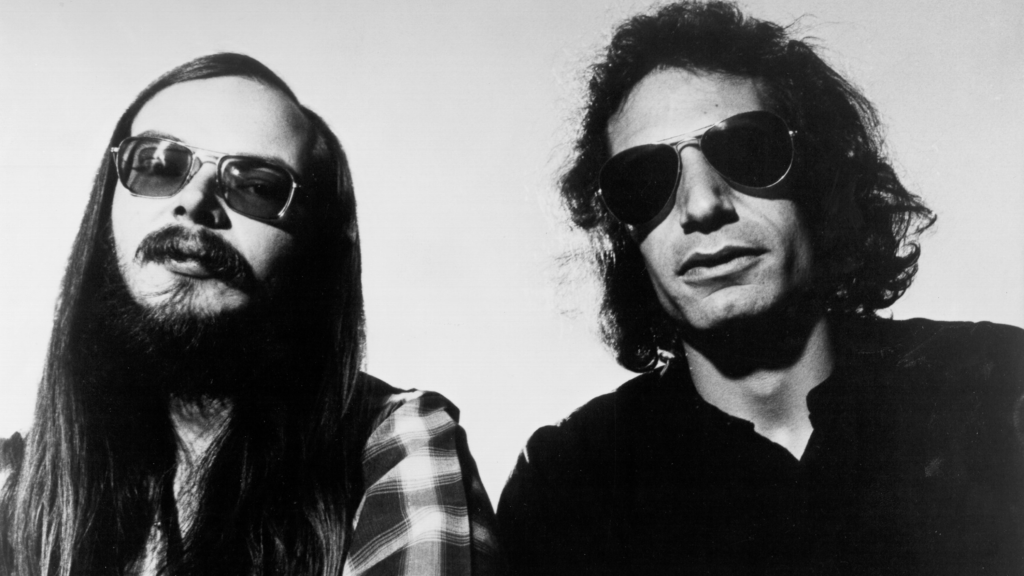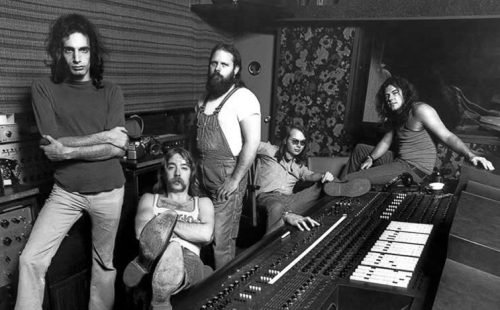In the world of music recording, few stories resonate quite like the time Steely Dan, committed to absolute sonic perfection, spent over six hours perfecting a single snare drum hit. This anecdote isn’t just an insight into their meticulous methods; it epitomizes the obsessive commitment to detail that Donald Fagen and Walter Becker, the masterminds behind Steely Dan, brought to the studio. Such stories have cemented their reputation not just as musicians but as revolutionary studio savants whose influence still echoes in the music industry today.
Formed in the early 1970s, Steely Dan defied the conventional norms of rock and roll, embedding elements of jazz, rock, funk, and sophisticated studio electronics into their music. This blend, however, was not the only thing that set them apart. From the outset, Fagen and Becker viewed the studio itself as an instrument, a place where sound could be sculpted with the precision of a master jeweler. Their approach was not common at the time, when many bands thrived on the raw, live energy captured in minimal takes.
Explore how Steely Dan’s perfectionism in the studio, often bordering on the obsessive, not only shaped their signature sound but also pushed the boundaries of what could be achieved in music production. Their relentless pursuit of perfection led to innovations and standards that have influenced generations of musicians and producers, making their approach a critical study in the evolution of recording technology and music production.
The Genesis of Steely Dan

The story of Steely Dan begins not on a stage, but within the hallowed halls of Bard College in New York, where Donald Fagen and Walter Becker first crossed paths in 1967. United by a sarcastic sense of humor and a profound dissatisfaction with popular music of the time, the duo formed a musical partnership that would evolve into one of the most sophisticated acts in rock history. After moving to Brooklyn and engaging in various music gigs, including work on soundtracks and advertising jingles, Fagen and Becker officially formed Steely Dan in 1972, named after a steam-powered dildo from William S. Burroughs’ novel “Naked Lunch.”
From the outset, Steely Dan was envisioned as a studio-bound project. Fagen and Becker’s shared vision was to create music that was meticulously crafted and polished, diverging sharply from the more straightforward rock acts of the era. Their approach was to use the studio as a compositional tool, a place to manipulate sound and layer musical ideas with the precision their complex arrangements required.
Musical Influences
The musical influences of Steely Dan are as eclectic as they are profound. Becker and Fagen drew heavily from jazz, with its complex chord progressions and improvisational elements, embedding these into the fabric of rock music. The jazz influences are evident in their use of extended chords and harmonies, which became a hallmark of their sound. They admired the work of jazz greats like Duke Ellington, Charlie Parker, and John Coltrane, whose influences can be subtly traced in the intricate structures of their music.
But jazz was not their only influence. Steely Dan’s music also displays an astute absorption of popular music styles ranging from rock and R&B to blues and funk. Artists like the Beatles, the Rolling Stones, and Motown acts left an indelible mark on their music, contributing to the creation of a sound that was both accessible and densely layered. The duo also had a keen appreciation for the storytelling and lyrical dexterity of Bob Dylan and the literary wit of writers like Kurt Vonnegut and Thomas Pynchon, influences which permeated Fagen’s lyrics.
Steely Dan’s Recording Ethos

Early Days and Changes
Steely Dan’s recording journey began with their debut album, Can’t Buy a Thrill (1972), which was characterized by a relatively straightforward approach compared to their later works. Initially, the band functioned more traditionally with a stable lineup and played most of the instruments themselves. This album, featuring hits like “Reelin’ in the Years” and “Do It Again,” was marked by its catchy hooks and rock sensibilities, yet hinted at the complex arrangements that would later define the band.
As Steely Dan progressed, Fagen and Becker gradually shifted their methodology, moving away from the conventional band format after their third album, Pretzel Logic (1974). They ceased touring and became a studio-only band, which allowed them to focus intensively on their recordings. By the time they released Katy Lied in 1975, Steely Dan had begun to exploit the studio as their primary instrument, leveraging advanced recording technology and enlisting some of the best session musicians in the industry. This shift marked a significant evolution in their sound and approach, as each album increasingly reflected their obsession with achieving the perfect sonic landscape.
Philosophy
The core philosophy of Steely Dan’s recording process was the relentless pursuit of sonic perfection. Fagen and Becker were known for their perfectionist tendencies, which included demanding numerous takes and obsessing over minor sonic details. This pursuit often led to innovative uses of technology and novel recording techniques. For example, they were among the first to adopt 16-track recorders and later moved to 24-track recording to capture their complex arrangements more effectively.
Their philosophy extended to their selection of musicians. Only those who could precisely execute the complex scores and bring the necessary feel to the recordings were chosen. Legends like guitarists Larry Carlton and Lee Ritenour, drummer Steve Gadd, and bassist Chuck Rainey contributed to recordings that showcased a level of precision and creativity that was unparalleled at the time. Each musician’s part was meticulously crafted and often recorded in isolation, ensuring that every note played contributed to the overall perfection of the sound.
Fagen and Becker’s approach was not merely about technical precision; it also involved a deep experimentation with musical form and harmony, drawn from their jazz influences. They would often rewrite and rearrange songs until they reached what they felt was a perfect balance between melody, harmony, and rhythm. This meticulousness in the studio was both celebrated and criticized, as it pushed the boundaries of what was technically and musically possible at the expense of a more spontaneous rock ‘n’ roll energy.
Techniques and Innovations

Recording Techniques
Steely Dan’s recording techniques are a showcase of innovation and precision, hallmarks that set their music apart in the annals of rock and jazz fusion. Central to their approach was the meticulous layering of tracks, a technique that allowed for a dense and harmonically complex sound. For instance, they often recorded multiple takes of the same part, then meticulously chose the best segments from each to create a composite track that met their exacting standards. This process could be extremely time-consuming, with reports of the band spending days to perfect just a few seconds of music.
Another significant technological innovation Steely Dan embraced was the use of the Wendel sampler, an early drum machine and sampler developed by engineer Roger Nichols, who was integral to many of the band’s studio innovations. The Wendel was used famously on their album Gaucho (1980), particularly on the track “Hey Nineteen,” where it provided a perfect drum track that was impossible to distinguish from a live drummer. This device was capable of sampling and replicating drum sounds with such precision that it satisfied Fagen and Becker’s demand for sonic perfection.
Further, they were pioneers in using digital audio technology. The introduction of the dbx noise reduction system allowed them to record with fewer artifacts and clearer sound, a significant improvement over the standard recording practices of the early 1970s. This embrace of emerging technology not only enhanced the clarity and detail of their recordings but also allowed them more creative freedom in the studio.
Innovative Use of Technology and Musicians
Steely Dan’s use of session musicians played a crucial role in achieving their distinctive sound. Rather than relying on a fixed band, Fagen and Becker hired some of the best musicians in the business, choosing them based on the specific demands of each song. This approach allowed them to tailor the playing style and expertise of each musician to the precise requirements of their complex arrangements. Musicians like Jeff Porcaro, Bernard Purdie, and Victor Feldman brought unique qualities to the drum tracks, while guitarists like Larry Carlton and Denny Dias added iconic solos that became central to the songs’ identities.
The selection of these musicians was based not just on their technical prowess but also on their ability to contribute creatively within the tightly controlled framework laid out by Fagen and Becker. This high standard often meant that musicians would be required to perform numerous takes, sometimes running into the hundreds, to capture a part perfectly. This extensive use of session talent also highlighted Steely Dan’s innovative spirit—embracing a variety of playing styles and techniques to enrich their music.
In their technological pursuits, Steely Dan also led the way in multi-track recording, moving beyond the standard 16-track setups of the early 1970s to 24-track recordings by the mid-1970s. This allowed for greater separation of instruments during recording, providing more control during the mixing phase and enabling the intricate layering for which they became famous.
Case Studies

“Aja” (1977)
Steely Dan’s sixth studio album, Aja, is often considered a pinnacle of recording artistry, combining complex jazz harmonies with rock sensibility and pristine studio craftsmanship. This album showcases Steely Dan at their most ambitious, both musically and technically.
“Deacon Blues”: This track exemplifies Steely Dan’s meticulous studio work and complex songwriting. The song features a sophisticated structure with a mix of saxophone solos, a sleek rhythm section, and layered backing vocals that create a lush, immersive sound. The perfectionism is evident in the choice of musicians, including Pete Christlieb on the tenor saxophone, whose solo was recorded after numerous takes to capture the exact mood Becker and Fagen desired.
“Peg”: Famous for its bright, catchy chorus and Michael McDonald’s backing vocals, “Peg” demonstrates the band’s obsessive approach to recording. The guitar solo by Jay Graydon was famously perfected after about seven hours of work and more than a dozen attempts, chosen from numerous other sessions with different guitarists. This track is also a prime example of their innovative use of the Mu-Tron III envelope filter, giving the guitar a distinctive sound that fits perfectly within the polished mix.
“Gaucho” (1980)
Gaucho represents another high mark in Steely Dan’s studio perfectionism, with its sound characterized by even greater technical refinement and complexity than Aja.
“Babylon Sisters”: The opening track features a shuffle beat, achieved through a blend of live drumming and the innovative use of the Wendel sampler, which added a precise rhythmic underlay to the groove. This meticulous blending of technology and musicianship highlights their relentless pursuit of the perfect sound.
“Hey Nineteen”: This song is a testament to Steely Dan’s mastery of the studio as an instrument. The use of the Wendel drum machine provided a flawlessly timed rhythm track that musicians could overlay, creating a tight, polished final product. The track is also notable for its lyrical sharpness and the seamless integration of electronic and acoustic elements.
Song Breakdown: Complexity and Craft
“Kid Charlemagne” (from “The Royal Scam”, 1976) The guitar work by Larry Carlton on “Kid Charlemagne” is often cited as some of the best in rock history. The recording of this song required Carlton to deliver a performance that matched the complex overlay of jazz chords and a funky rhythm section. His solo, which was crafted through a series of sessions, is a showcase of precision and creativity, aligning perfectly with the song’s narrative and harmonic structure.
“Black Cow” (from “Aja”, 1977) “Black Cow” is a prime example of Steely Dan’s layered production technique. The track starts with a compelling keyboard riff, over which layers of bass, vocals, horns, and other elements are meticulously added. Each layer was recorded separately, often with multiple takes to ensure that it contributed just the right feel to the overall mix. The song’s sophisticated blend of pop, jazz, and soul elements illustrates the duo’s ability to synthesize diverse musical influences into a cohesive and strikingly original whole.
Through these case studies, it is evident that Steely Dan’s recording sessions were not merely about capturing music but crafting sonic masterpieces. Each track served as a canvas for their experimentation with sound, technology, and musician craftsmanship, ultimately forging a legacy that has profoundly influenced the music industry.
The Impact of Their Perfectionism

On Their Music
Steely Dan’s obsession with perfection profoundly shaped their music, leading to a body of work renowned for its precision, sophistication, and timeless appeal. Each album crafted by Donald Fagen and Walter Becker stands as a testament to their painstaking efforts in the studio, which resulted in a sound characterized by its clarity, depth, and detail. This attention to every musical element ensured that each song was not just heard but experienced, with listeners able to discern each nuanced layer of sound.
This relentless pursuit of sonic perfection sometimes led to a high degree of polish that some critics argued stripped the music of its spontaneity and raw emotional power. However, for Steely Dan’s fervent fans and many music aficionados, the pristine production and complex arrangements enhanced the listening experience, allowing the band’s clever lyrics and intricate melodies to be delivered with unmatched clarity and impact.
On the Industry
Steely Dan’s perfectionism also left a significant mark on the music industry, particularly in the areas of recording and production. Their innovative use of technology and session musicians set new standards for what could be achieved in a recording studio. For instance, their early adoption of digital recording technology and the Wendel drum sampler heralded a shift towards more technologically driven music production in the late 1970s and 1980s.
The duo’s approach to hiring skilled session musicians for specific tracks rather than relying on a consistent band lineup influenced how other artists and producers approached recording. This method demonstrated the benefits of pairing the unique requirements of each song with a musician whose style and expertise could best serve the piece, encouraging a more bespoke approach to album production.
Furthermore, Steely Dan’s demand for perfection influenced the broader studio culture, promoting a meticulousness that has been emulated by countless recording artists. The expectation for high fidelity sound and layered production techniques became more pronounced in the industry following their success. Artists and producers who sought to replicate the clarity and complexity of Steely Dan’s recordings pushed for advancements in recording technology and techniques.
The Legacy of Steely Dan

Throughout this exploration of Steely Dan’s journey, we’ve witnessed how Donald Fagen and Walter Becker’s relentless pursuit of perfection not only defined their music but also left a lasting imprint on the recording industry. From their early days as a band focused on live performances to their transformation into studio-centric pioneers, Steely Dan relentlessly pushed the boundaries of what music could be. Their meticulous attention to detail, innovative use of technology, and pioneering recording techniques helped forge a sound that is both timeless and profoundly influential.
Steely Dan’s work ethic in the studio, characterized by an obsessive refinement of every track, set new standards for sound quality and musical sophistication. Their method of employing top-tier session musicians to realize their artistic vision revolutionized recording practices, promoting a level of professionalism and excellence that has become aspirational in the music industry. Their albums, especially landmarks like Aja and Gaucho, stand as masterclasses in production, influencing generations of musicians and producers across diverse musical landscapes.
Closing Thought
Steely Dan’s relentless pursuit of perfection serves as a compelling lesson on the power and pitfalls of artistic obsession. Their meticulous approach to music production underscores a broader cultural narrative in music: that the quest for sonic perfection, while sometimes criticized for being overly fastidious, can yield art that resonates across decades and influences countless other artists. In a culture increasingly preoccupied with immediacy and the rapid consumption of music,
Steely Dan’s legacy is a reminder of the value of craftsmanship in music—of taking the time to perfect a sound, a lyric, a harmony. Their story encourages today’s artists to embrace both innovation and the meticulous care that can transform simple songs into enduring works of art. This balance of innovation, excellence, and enduring appeal encapsulates the timeless relevance of Steely Dan in the annals of music history.
